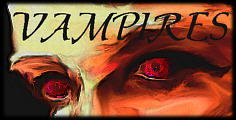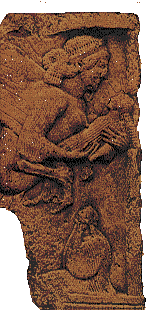|Vampires Then and Now| ++ |Vampires of the Eclipse| ++ 800 x 600


EARLY TYPES OF VAMPIRES
Early vampires date back at least four thousand years, back to ancient Assyrians and Babylonians of Mesopotamia.Ekimmu -- a malefic spirit in Assyria that was a cross between a demon and ghost. In addition to ghostly haunting, it often attacked and devoured its victims. Sometimes this creature chose to possess its victims rather than physically devouring them.
Lamastu (or Lamashtu) was a demon goddess feared by Mesopotamians since she preyed on humans. Her name can be translated to "she who erases". Assyrian legend says she is the daughter of the sky god, Anu. She crept into houses at night to kill babies, in their cribs or in the womb. Thus she was responsible for sudden infant death syndrome and miscarriage. She preyed on adults, too, bringing disease, sterility, nightmare, not to mention sucking blood from young men. She is depicted with wings and birdlike talons, and sometimes with a lion's head.
Lilitu, closely related to Lamastu, was of Babylonian origin. In ancient Hebrew culture this female demon was called Lilith. Talmudic legend places her as the first wife of Adam, banished from Eden for being the earliest feminist on record by refusing to obey her husband. She was, after all, the original woman (by some accounts), having been created from the earth alongside of Adam.
Legend and superstition evolved Lilith into a night demon. She flew out of the dark to suck the blood of infants and children. She was blamed for causing men to have erotic dreams in a time when the loss of semen was considered horrific.
When Christianity ascended one of the many thrones of human belief, early church fathers assigned the Queen of Night her own Army of Hell which waged fierce war on the good. Incubi (male) and succubi (female) were spirits or demons assuming human form to seduce unwilling victims. Interestingly, many a nun or woman of virtue became pregnant this way.

|
The lamia of ancient Greece was similar to Lilith. She was a demon with the head and breasts of a woman, but her scaly body was that of a large, winged serpent. She was also a night creature preying primarily on the innocent young, because one version of her story had her as a mortal lover of Zeus. Hera, the jealous wife of Zeus, made her insane so that Lamia ate all her children. Once Lamia realized what she had done, she became a raging monster that attacked the young children of others.
Romans had their own version, calling her the strix. This was also a type of screech owl known in Roman times. The plural in Latin is strigae which evolved over time into strega, or witch, in Italian. |
Ancient Greeks also feared the empusai, the malicious daughters of Hecate, the goddess of witchcraft. The empusai originated from Hades and would emerge at night in the form of beautiful women. They seduced shepherds before devouring them.A similar creature, the baobhan sith, pronounced "baavan shee," belonged to the folklore of the Celts in Scotland.
| Early Types of Vampires | European Vampires | Eastern Vampires |
|In a Welcoming Vein: Vampire Renaissance map|
+ + +
|The Entrance Gate|07.03.03
Most graphics created or adapted by Dracowylde
Vampires Then and Now